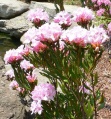Rhododendron
| Rhododendron |
|---|

|
| Scientific Classification |
|
| Selected Species |
|
Rhododendron is a genus of large flowering plants which contains more than 850 species including the Azaleas. The name comes from the Greek word rhodos meaning, "rose" and dendron meaning, "tree." Given the size of some reaching more than 100ft tall, it is indeed appropriately called a Rose Tree. The Rhododendron flower is popularly used for state and national symbolism. It is the state flower of Washington, and of the state of Sikkim in India. It is also the national of flower of Nepal.
Anatomy
Rhododendrons are an extremely diverse group exhibiting an enormous variety of sizes and shapes. Although most are shrub in form, they range in size from alpine groundcovers growing no more than a few inches high to trees more than 100 feet tall. Leaf size ranges from less than 1/4 inch to over three feet long, and shapes include round, lance, and elliptical. Rhododendrons are best known for their flowers which may come in various shades of white, red, pink, yellow, blue, purple, magenta and orange. There is also quite a bit of diversity in bark texture and color as well.
Reproduction
Rhododendrons reproduce sexually. In the flower there are male reproductive structures called stamens. Each one carries a filament, which bears the anther at its tip. It eventually divides to form the sperm cells and the pollen wall could decay that fossil pollen even if it was buried for more than 1000 years. The female is called the pistil. Its divvied into three sections which are a stigma (sticky receptive surface) in an elongated style which elevates the stigma into position for the pollen to assume its collective from. At the bottom of the flower is the female plant ovary which becomes a fruit and undeveloped seeds. Or it’s also known as an egg waiting to be fertilized by sperm.
The pollen transfer is by animals more than the wind or flowing water. Honey bees and hummingbirds are particularly beneficial relationships with the Rhododendron as they are rewarded with nutrients and food and the plant continuous its life. The most special glands (nectarines) which are located down at the base of the pistil, stamens, and petals are a nutritious liquid which is called nectar. Rhododendrons provide ample guides to help pollinators find their way to the flower nectar, including brilliant colors and starlike patterns on its petals. We can't see the ultraviolet light but its wavelengths are visible to all different kinds of insects.
Ecology
This genus is a widely distributed group, but most species are native to Asia and can be found in the mountains of Indo china, Taiwan, Japan, Korea. Several thrive in Europe and in North America particularly in the Pacific Northwest. They grow best in climates that avoid extremes in temperature and have substantial rainfall. They also require a slightly acidic soil. Nevertheless, some like summer drought while some like alkaline soil. Azaleas can grow either as evergreen or semi-evergreen, and in rare cases deciduous.
Gallery
Related References
- Rhododendron Wikipedia
- Rhododendron Rhododendron Species Garden
- Rhododendron Rhododendron





